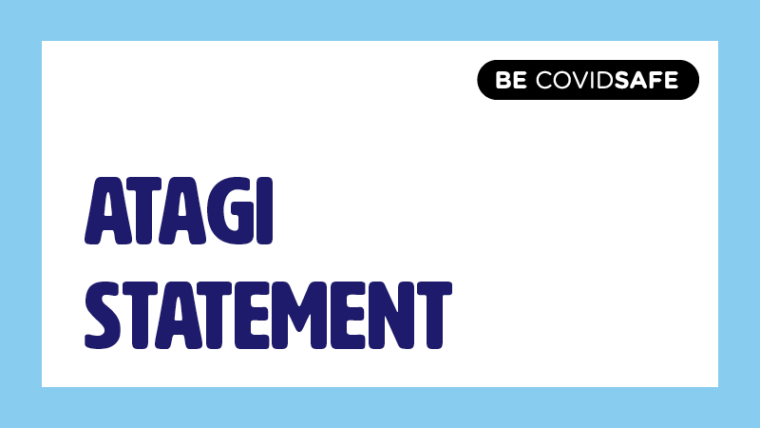
Summary of Recommendations
- ATAGI recommends COVID-19 vaccination for children aged 6 months to with severe immunocompromise, disability, and those who have complex and/or multiple health conditions which increase the risk of severe COVID-19. These include children with the following or similar conditions:
- Severe primary or secondary immunodeficiency, including those undergoing treatment for cancer, or on immunosuppressive treatments as listed in the ATAGI advice on 3rd primary doses of COVID-19 vaccine in individuals who are severely immunocompromised;
- Bone marrow or stem cell transplant, or chimeric antigen T-cell (CAR-T) therapy;
- Complex congenital cardiac disease;
- Structural airway anomalies or chronic lung disease;
- Type 1 diabetes mellitus;
- Chronic neurological or neuromuscular conditions; or
- A disability that requires frequent assistance with activities of daily living, such as severe cerebral palsy or Down Syndrome (Trisomy 21).
- The recommendation is for 2 primary doses, except for those with severe immunocompromise who require 3 primary doses. The recommended interval between each dose is 8 weeks.
- A paediatric formulation of the Moderna COVID-19 vaccine (Spikevax) was provisionally approved by the Therapeutic Goods Administration (TGA) on 19 July 2022 for use in children aged 6 months to 5 years and can be used for children aged 6 months to
- ATAGI reiterate the previous recommendation that all children aged 5 years or older are recommended to receive a two-dose course of COVID-19 vaccine.
- ATAGI does not currently recommend vaccination for children aged 6 months to not in the above risk categories for severe COVID-19. These children have a very low likelihood of severe illness from COVID-19. However, this is under ongoing consideration based on data on the disease burden and epidemiology, vaccine supply, emerging data on vaccine use in this age group, and availability of new COVID-19 vaccines for this age group.
- Parents of eligible children aged 6 months to
ATAGI’s guidance takes into account:
- The very low risk of severe COVID-19 (e.g. hospitalisation due to COVID-19) in healthy children aged 6 months to
- A relatively low rate of paediatric inflammatory multisystem syndrome (PIMS-TS) following COVID-19 in children aged 6 months to
- A clinical trial which included approximately 5500 children aged 6 months to 5 years and showed that the Moderna COVID-19 vaccine provided modest protection against infection (vaccine efficacy 35-52%) with the Omicron variant after two doses (25 mcg per dose). Safety data from the trial reported patterns of vaccine-related adverse events commonly seen in other age groups after mRNA vaccination, although fever was more common in this age group compared to older children and adults. Most side effects were mild to moderate and lasted approximately 1-2 days. Children in this trial who had evidence of a previous SARS-CoV-2 infection were more likely to have side effects after vaccination.
- The vaccine efficacy data were against infection with early Omicron variants and there may be differences in efficacy against the currently circulating SARS-CoV-2 subvariants BA.4 and BA.5. Modest efficacy against infection also suggests protection will predominantly be against severe illness rather than infection, although there were insufficient episodes of severe illness in this clinical trial to assess this specific outcome.
- Data on benefits in children with complex medical issues or severe immunocompromise are currently limited, but vaccination is recommended based on first principles and evidence of benefit in other age groups.
- Up to one in four children in this age group had a fever following vaccination with Moderna vaccine, with higher rates seen in those with a history of previous COVID-19. As fever in this age group can sometimes result in medical review and/or investigations, and occasionally trigger a febrile convulsion, the side effect profile for this vaccination needs to be considered in the risk-benefit discussion.
- There is insufficient evidence to suggest that vaccination of infants and children would impact community transmission.
- ATAGI notes that there are currently constraints on the global availability and domestic supply of the Moderna vaccine for children aged 6 months to
ATAGI will continue to monitor evolving evidence in areas of current uncertainty including vaccine effectiveness, duration of protection, and vaccine safety in this age group including data on febrile convulsions, safety of co-administration with other vaccines, and rare adverse events such as myocarditis/pericarditis (noting there have been very few cases of vaccine associated pericarditis or myocarditis in the 5-11 year old age group). ATAGI’s recommendations may be updated as alternative brands of COVID-19 vaccine for this age group or variant vaccines become available and as COVID-19 epidemiology changes including the appearance of any new variants of concern.
Dosing and Schedule
The recommended schedule for vaccination in this age group is 2 doses, 8 weeks apart with a minimum interval of 4 weeks for Moderna vaccine in special circumstances. See the COVID-19 Clinical guidance for variations on vaccination schedule.
The recommended dose of Moderna for this age group is 25 mcg, compared with 50 mcg dose for children aged 6 to 11 years, and 100 mcg dose for people aged 12 years and over.
The Moderna vaccine for children aged 6 months to 5 years is a new formulation (blue cap vial) consisting of a new concentration of 100 mcg/mL in multi-dose vials containing 10 doses, each 0.25 mL. ATAGI reminds immunisation providers to be vigilant for the potential for dosing errors with the Moderna vaccine in all children, and to ensure that the correct formulation is selected for the child to be vaccinated.
Children with severe immunocompromise should receive a 3rd primary dose, 8 weeks after the 2nd dose (minimum 4 weeks in exceptional circumstances, e.g. when there is anticipated intensification of immunosuppression). This advice is based on first principles of decreased immune responses seen in other age groups with these conditions after only 2 doses. See the ATAGI advice on a third primary dose of COVID-19 vaccine in individuals who are severely immunocompromised.
Coadministration with other vaccines in children aged 6 months to
Moderna paediatric COVID-19 vaccine can be co-administered with other vaccines if separation of vaccines would be logistically challenging, such as with outreach programs to remote areas, or children receiving complicated catch-up schedules. Parents and guardians should be made aware that co-administration may increase the likelihood of mild to moderate adverse events including fever.
Where possible, it is preferable to separate administration of Moderna paediatric COVID-19 vaccine and other vaccines by 7-14 days, depending on what vaccine has most recently been administered, to minimise the risk of adverse events such as fever. Measles-Mumps-Rubella live vaccine causes fever 7-10 days after vaccination, while with most inactivated vaccines, fever occurs within 3 days after vaccination. Receipt of routine vaccines was generally excluded in clinical trials from 14 days before the first dose to 14 days after the second dose, except for influenza vaccine which was separated from any Moderna COVID-19 vaccine by at least 14 days. This recommendation may change once more co-administration data are available.
Antipyretics
Prophylactic paracetamol to reduce the risk of fever is not routinely recommended prior to or immediately after vaccination. However, paracetamol or ibuprofen can be given as required after vaccination for any discomfort or fever.
Timing following SARS-CoV-2 infection
ATAGI currently recommends COVID-19 vaccination be deferred for 3 months after a confirmed SARS-CoV-2 infection. Vaccination after this interval is likely to provide a better immunological boost and optimise the duration of protection.
Children aged 5 years of age
All children aged 5 years and above are already recommended for COVID-19 vaccination as per ATAGI’s advice for children 5 – 11 years. Previously, only the Pfizer vaccine was registered for use in 5 year olds and Moderna was registered from 6 years of age. However, 5 year old children may now receive either Moderna 25 mcg or Pfizer 10 mcg COVID-19 vaccine. It is preferred to complete a primary vaccination schedule in children aged 5 years or older with the same brand of vaccine for both doses.
Children who turn 6 years old between doses should receive the dose that is applicable to them on the day of vaccination. Providers should note carefully that the dose of Pfizer COVID-19 vaccine is the same for children aged 5 years and those aged 6 to 11 years, while the Moderna dose increases from 25 mcg in 5 year old children (0.25mL of 100 mcg/mL blue cap vial) to 50 mcg for those aged 6 to 11 years (0.25mL of 200mcg/mL red cap vial).
Rationale
Burden of COVID-19 in children aged 6 months to Disease Epidemiology
Since late November 2021, the Omicron variant has become established as the dominant strain of SARS-CoV-2. Initial waves of BA.1 and BA.2 have resulted in substantial numbers of Australian children who have been infected with SARS-CoV-2. Australian serosurvey data in June 2022 estimates that 46.2% of adults have contracted SARS-CoV-2 infection.1 The proportion of children aged 6 months to
Risk of severe disease
Despite large numbers of infections occurring in children in Australia and internationally, studies reveal that very low numbers of children aged 6 months to 2 A study in Iceland revealed that over 95% of SARS-CoV-2 infected children aged 6 months to 7 years during March 2020 to August 2021 had no or mild symptoms3; while a comprehensive review of all children who died due to COVID-19 between March 2020 to December 2021 in the United Kingdom revealed a very low rate of mortality in children (infection fatality rate of 0.61 per 100,000 infections in all children; and an even lower rate of 0.3 per 100,000 infections in children aged 1 to 4 years). Of those children who died due to COVID-19, three-quarters of deaths occurred in children with an underlying condition: especially severe neurodisability or significant immunocompromise.4
Overall, severe COVID-19 in children is extremely rare, even among children with underlying conditions.3,5-8 During the Omicron period, there has been a low burden of severe disease in children as shown by unpublished hospitalisation data reviewed by ATAGI from tertiary paediatric hospitals, and the Paediatric Active Enhanced Disease Surveillance (PAEDS) network.
While studies have shown vaccination may reduce the risk of paediatric inflammatory multisystem syndrome (PIMS-TS) in children9, children aged 6 months to 10,11
Immunogenicity of the COVID-19 vaccine in children aged 6 months to
The evidence regarding the immunogenicity of Moderna vaccine in infants and children 6 months to 5 years derives primarily from the phase 2-3 P204 clinical trial run by Moderna. The presumed protective efficacy was determined through immunobridging, i.e. the demonstration of an equivalent or better immune response in infants and children 6 months to 5 years compared with the immune response in young adults 18 to 25 years, where efficacy has previously been shown against the ancestral strain. The neutralising antibody responses were measured in a small subset of 230 infants/toddlers aged 6 to 23 months and 264 children aged 2 to 5 years, and were compared to the neutralising antibody responses of 295 young adults aged 18 to 25 years. These neutralising antibody titres were 1.28 times higher in children aged 6 to 23 months, and equivalent in those aged 2 to 5 years to those seen in 18 to 25 year old adults. These neutralising antibody responses were against an ancestral SARS-CoV-2 strain (D614G), not the Omicron variant.
A sub-analysis investigating the difference in neutralising antibody responses between participants who had a prior SARS-CoV-2 infection and those who did not have evidence of prior infection, showed that infants and children with prior SARS-CoV-2 infection had a higher neutralising antibody response to vaccination. The neutralising antibody response was 3.8 times higher in infants/toddlers aged 6 to 23 months, 3.4 times higher in children 2 to 5 years, and 2.8-2.9 times higher in adults 18 to 25 years with prior infection compared to those with no evidence of prior infection in each respective age group.
This trial excluded infants who were premature and/or of low birth weight and excluded many children with serious underlying health conditions, and children with a history of febrile convulsions. Additionally, neither co-administration with other childhood vaccines nor vaccination with other vaccines within 14 days of each Moderna dose were permitted in the study. Therefore, the immune response generated in children with underlying medical conditions or when co-administering other infant and childhood vaccinations has not been studied, although no concerns have been raised about the use and benefits of COVID-19 vaccines in these groups in other age groups.
Vaccine efficacy of the COVID-19 vaccine in children aged 6 months to
There is limited evidence on the efficacy of Moderna in infants and children 6 months to 12-15 All cases of COVID-19 which occurred in the P204 clinical trial were found to be due to the Omicron variant. It is important to note that efficacy demonstrated in these trials was likely to be against the BA.1 Omicron variant with an expected reduction in protection against infection with current BA.4 and BA.5 sub-variants which demonstrate a greater degree of immune escape.16
Vaccine efficacy against symptomatic COVID-19 from 14 or more days after dose 2 in infants/toddlers 6 to 23 months (N=2024 participants) and children 2 to 5 years (N=3452) without evidence of prior SARS-CoV-2 infection was:
- 50.6% (95% confidence interval [CI] 21.4 to 68.6) in infants/toddlers 6 to 23 months
- 36.8% (95% CI 12.5 to 54.0) in children 2 to 5 years
When participants with prior SARS-CoV-2 infection were included, vaccine efficacy against symptomatic COVID-19 from 14 or more days after dose 2 was:
- 52.1% (95% CI 24.3 to 69.3) in infants/toddlers aged 6 to 23 months
- 34.5% (95% CI 9.8 to 52.0) in children aged 2 to 5 years
There were no cases of severe COVID-19 reported as of the data cut off of the P204 trial, which had a median 71 days of follow-up post-dose 2. While efficacy is modest, ATAGI expects vaccination to offer greater protection against severe disease compared to infection with Omicron as has been shown in other age groups.17
As infants and children with chronic medical conditions, including severe immunocompromise were excluded from the P204 trial, the efficacy of the Moderna vaccine in these groups is not known. However, it is anticipated that these high-risk groups and severely immunocompromised children aged 6 months to rd primary dose to improve immune responses to vaccination, similar to older people.
Risks of vaccination against COVID-19 in children aged 6 months – Safety data from clinical trials12-15
The P204 Moderna trial demonstrates that local reactions were more frequently reported post-dose 2 among the entire 6 month to 5 year cohort, and were more common (particularly lymphadenopathy) in children who had previously had SARS-CoV-2 infection. Lymphadenopathy was more frequently reported after Moderna vaccination than placebo, and more frequently reported in the cohort aged 6 to 23 months (1.5% Moderna vs. 0.2% placebo) than the cohort aged 2 to 5 years (0.9% Moderna vs.
The safety profile of the Moderna vaccine in children aged 6 months to 5 years was similar to that of the Moderna vaccine in other age groups, with systemic events more frequently reported after dose 2. Fever rates after dose 2 were high for most age groups, but relative to other ages, infants and young children aged 6 months to 5 years had higher rates of fever after both dose 1 and dose 2 than many of the other groups.
Fever rates (≥38oC) after Moderna COVID-19 vaccine by age.13,18
Age-group | Dose 1 Moderna | Dose 2 Moderna | Any dose |
|---|---|---|---|
6 to 23 months | 11.0% | 14.6% | 21.8% |
24 to 36 months | 11.3% | 18.9% | 26.1% |
37 months to 5 years | 7.7% | 16.0% | 20.9% |
6 to 11 years | 3.3% | 23.9% | 25.7% |
12 to 17 years | 2.5% | 12.2% | 14.7% |
18 to 64 years | 0.9% | 17.4% | 18.0% |
≥65 years | 0.3% | 10.0% | 10.2% |
≥18 years overall | 0.8% | 15.5% | 15.8% |
Most fevers in children occurred within 2 days of vaccination and were of short duration (median 1 day for fever), with 1 in 3 vaccine recipients requiring anti-pyretic medication. Additionally, children who had previously had SARS-CoV-2 infection were more likely to have a fever than those without a history of past infection. As the P204 trial had only approximately 6-8% of trial participants with evidence of previous infection, which is lower than currently seen in Australia, post-vaccination fever may be seen more frequently after vaccination with Moderna in the Australian context than was seen in the study. ATAGI supports the use of antipyretic medication such as paracetamol to manage fevers in vaccinated infants and young children. Routine paracetamol prior to immunisation or in afebrile children to reduce the risk of fever is not currently recommended.
Young children may be prone to febrile convulsions, as these commonly occur in around 2-5% of children between the ages of 6-months to 5-years, with a peak incidence between 12 and 18 months of age.19 These occur most frequently due to viral infections but can be precipitated by fever after vaccination. One vaccine-related febrile convulsion was reported during the P204 trial. This occurred in a 17 month old child, 2 days after dose 1. Another 3 febrile convulsions were reported in the 6 to 23 month age group but were considered not related to vaccination. Importantly, ATAGI notes that children with a history of febrile convulsion were excluded from this study, and that there may be an increased risk of recurrence of febrile convulsions in children who have had a previous febrile convulsion. A child with a previous febrile convulsion from vaccination (including with a COVID-19 vaccine) is not contraindicated to receive a subsequent dose; parents should discuss the risks and benefits of future doses with their child’s GP.
ATAGI notes that the P204 trial was not powered to detect rare cardiac adverse events and uncertainties around the rates of potential vaccine-related myocarditis/pericarditis in this infant and young child age-cohort remain. No cardiac events reported during the P204 trial met the USA Centers for Disease Control and Prevention (CDC) criteria for probable or confirmed myocarditis or pericarditis in the 6 month to 5 year cohort. ATAGI is continuing to monitor rates of rare adverse events including myocarditis as vaccination in this age group becomes more widespread internationally.
There were more medically attended adverse events (including any reported cases of COVID-19) considered related to vaccination compared to the placebo group in both the infant/toddler cohort aged 6 to 23 months (1.5% vs 0.8%) and in children 2 to 5 years (1.0% vs 0.3%). Data on adverse events specific to high-risk groups for Moderna vaccine are not yet available. Additionally, the safety of the Moderna vaccine when co-administered (or closely administered) with other infant and childhood vaccinations has not yet been studied.
Initial data on the use of the Moderna vaccine in this age group are reassuring. It has been approved in the USA for infants and children aged 6 months to 5 years at the 25mcg dose. For the period 18 June 2022 to 20 July 2022, just over 544,000 children under 5 years of age have received at least one dose of Moderna (25mcg) in the USA.20 Currently, no serious safety signals have been reported in the USA by the CDC or FDA. Second dose data may be expected from mid August 2022.
Conclusion
The recommendation of COVID-19 vaccination in children aged 6 months to
References
- The Kirby Institute, National Centre for Immunisation Research and Surveillance, Australian Red Cross Lifeblood, et al. Seroprevalence of SARS-CoV-2-specific antibodies among Australian blood donors, May-June 2022.
- Williams P, Koirala A, Saravanos GL, et al. COVID‐19 in New South Wales children during 2021: severity and clinical spectrum. Medical Journal of Australia 2022:2021.12.27.21268348.
- Thors V, Bjornsdottir KL, Love T, Haraldsson A. SARS-CoV-2 Infections in Icelandic Children: Close Follow-Up of All Confirmed Cases in a Nationwide Study. Pediatr Infect Dis J 2022.
- Bertran M, Amin-Chowdhury Z, Davies H, et al. COVID-19 Deaths in Children and Young People: Active Prospective National Surveillance, March 2020 to December 2021, England. SSRN Electronic Journal 2022.
- Bhopal SS, Bagaria J, Olabi B, Bhopal R. Children and young people remain at low risk of COVID-19 mortality. The Lancet Child & Adolescent Health 2021;5:e12-e3.
- Parcha V, Booker KS, Kalra R, et al. A retrospective cohort study of 12,306 pediatric COVID-19 patients in the United States. Sci Rep 2021;11:10231.
- Ward JL, Harwood R, Smith C, et al. Risk factors for PICU admission and death among children and young people hospitalized with COVID-19 and PIMS-TS in England during the first pandemic year. Nat Med 2022;28:193-200.
- McCormick DW, Richardson LC, Young PR, et al. Deaths in Children and Adolescents Associated With COVID-19 and MIS-C in the United States. Pediatrics 2021;148.
- Nygaard U, Holm M, Hartling UB, et al. Incidence and clinical phenotype of multisystem inflammatory syndrome in children after infection with the SARS-CoV-2 delta variant by vaccination status: a Danish nationwide prospective cohort study. The Lancet Child & Adolescent Health 2022;6:459-65.
- Cohen JM, Carter MJ, Ronny Cheung C, Ladhani S, Evelina P-TSSG. Lower Risk of Multisystem Inflammatory Syndrome in Children (MIS-C) with the Delta and Omicron variants of SARS-CoV-2. Clin Infect Dis 2022.
- Holm M, Espenhain L, Glenthoj J, et al. Risk and Phenotype of Multisystem Inflammatory Syndrome in Vaccinated and Unvaccinated Danish Children Before and During the Omicron Wave. JAMA Pediatr 2022.
- Das R. ACIP Presentation Slides: June 17, 2022 Meeting: Moderna COVID-19 vaccine (mRNA-1273): Safety, immunogenicity and efficacy in children ages 6 months through 5 years of age. 2022.
- Food and Drug Administration. Vaccines and Related Biological Products Advisory Committee Meeting June 14-15, 2022, FDA Briefing Document: EUA amendment request for use of the Moderna COVID-19 Vaccine in children 6 months through 17 years of age.
- Food and Drug Administration. Vaccines and Related Biological Products Advisory Committee Meeting June 15, 2022. FDA Review of Effectiveness and Safety of Moderna COVID-19 Vaccine in Children 6 Months through 5 Years of Age. Emergency Use Authorization Amendment.
- Food and Drug Administration. Vaccines and Related Biological Products Advisory Committee June 14-15, 2022 Meeting. mRNA-1273 PRIMARY SERIES 6 MONTHS TO 17 YEARS SPONSOR BRIEFING DOCUMENT.
- Hachmann NP, Miller J, Collier AY, et al. Neutralization Escape by SARS-CoV-2 Omicron Subvariants BA.2.12.1, BA.4, and BA.5. N Engl J Med 2022;387:86-8.
- UK Health Security Agency. COVID-19 vaccine surveillance report Week 24. 16 June 2022.
- Baden LR, El Sahly HM, Essink B, et al. Efficacy and Safety of the mRNA-1273 SARS-CoV-2 Vaccine. N Engl J Med 2021;384:403-16.
- Sawires R, Buttery J, Fahey M. A Review of Febrile Seizures: Recent Advances in Understanding of Febrile Seizure Pathophysiology and Commonly Implicated Viral Triggers. Front Pediatr 2021;9:801321.
- Centers for Disease Control and Prevention. COVID-19 Vaccinations in the United States. 2022.







